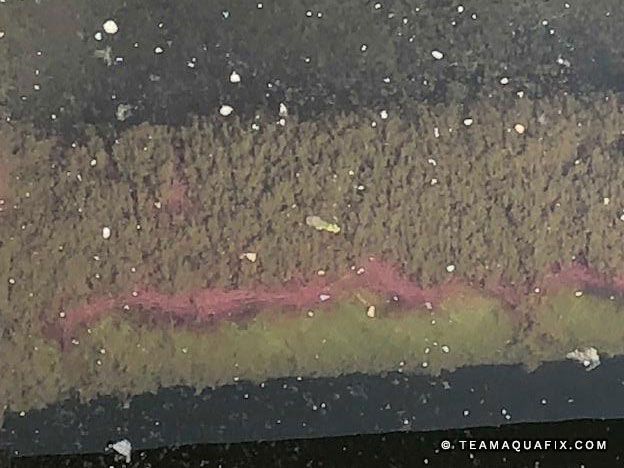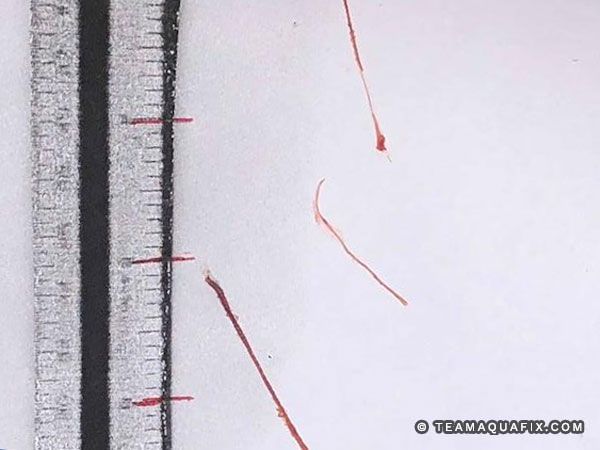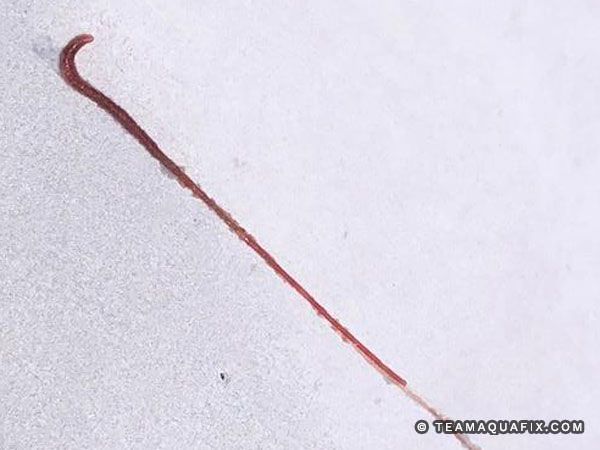
Tubifex worms attached to clarifier axle. The axle pictured is approximately 8″ across
But Aquafix is on the case. Below, we will describe a few case studies Aquafix has been involved in to help further the understanding of common approaches and their effectiveness.
Rhode Island Case Study
Aquafix was first introduced to Tubifex worms at a municipal treatment plant in Rhode Island. This 1 MGD RBC, was followed by three sand filters for up-flow nitrification and down-flow denitrification. The sand filters are approximately 20’ by 12’ by 8’ of sand. The Aquafix team came up with a two-part plan to kill both types of worms and clean the filters of excess sludge and proteins.
The operator used a chelated copper to kill the tubifex worms, but not harm the good biology. Qwik-Zyme P, a biocatalyst-based product, was then used to break down the food source that the worms had been living on, as well as to degrade the dead worms. The operators let both products soak for 24 hours and then backwashed to the head of the plant.
The results appeared very positive during the following weeks. They reported minimal tubifex presence in the sand filters. However, after that period of relief the tubifex worms reappeared. The prevailing theory was that a new supply of the worms was washing into the system daily, and because the source wasn’t treated, the population slowly rebounded.
Next the operator tried isolating the filters and applying a heavy dose of chlorine. While this did bleach the outside of the groups of worms, they noted that when a ball or mass of worms was broken open, there appeared to be healthy worms remaining inside the mass. They also tried bringing in loads of superheated water, and introducing it directly to the filters, several thousand gallons at a time. This was the most effective method at killing the worms, but again they came back.
We learned that there are various control programs that seem to have success at killing tubifex worms, but without treating the source of the worms, these treatments will just be temporary.

Grouping of tubifex worms removed from clarifier

Tubifex worm close up
Pennsylvania Case Study
This 8 MGD activated sludge plant had a synthetic media filtration system as one of its final treatment processes. Flow went into one of 3 basins and then through the cloth media. After several years of use, the media became colonized with tubifex worms and redworms.
Aquafix was able to provide our AQUABACxt and BugJuice to get rid of the redworms and nuisance midge flies that they hatched into with no issue.
The operators systematically took their basins offline, one by one, and removed the filtration media for a thorough cleaning. This left a mostly empty basin filled with water and many tubifex worms. This is the best trial we are aware of for looking at chlorine toxicity thresholds for tubifex worms in wastewater. The first basin was isolated for 72 hours, with a peak concentration of 300 ppm chlorine. Tubifex worms in this basin were fully killed. The second basin was treated in a similar manner, with similar results.
The third basin was isolated for 24 hours and treated with a chlorine concentration of 10 ppm. This basin did not achieve a complete kill of the tubifex worms, leading us to believe the required threshold is above 10 ppm chlorine.
The operator used a chelated copper to kill the tubifex worms, but not harm the good biology. Qwik-Zyme P, a biocatalyst-based product, was then used to break down the food source that the worms had been living on, as well as to degrade the dead worms. The operators let both products soak for 24 hours and then backwashed to the head of the plant.
The results appeared very positive during the following weeks. They reported minimal tubifex presence in the sand filters. However, after that period of relief the tubifex worms reappeared. The prevailing theory was that a new supply of the worms was washing into the system daily, and because the source wasn’t treated, the population slowly rebounded.
Next the operator tried isolating the filters and applying a heavy dose of chlorine. While this did bleach the outside of the groups of worms, they noted that when a ball or mass of worms was broken open, there appeared to be healthy worms remaining inside the mass. They also tried bringing in loads of superheated water, and introducing it directly to the filters, several thousand gallons at a time. This was the most effective method at killing the worms, but again they came back.
We learned that the threshold for killing tubifex worms with chlorine is above 10 ppm and below 300 ppm, but the exact ppm in unknown. Operators must balance the need to kill tubifex worms with the goal of not killing their good bacteria.
The Future of Tubifex Worm Treatment
Aquafix continues to learn more about tubifex worms and compiles the best information about treatment strategies and their effectiveness. What we know for sure is that the vast majority of wastewater plants with severe tubifex worm outbreaks have one thing in common: Settled Sludge. Tubifex worms thrive in areas of settled and stagnate sludge; the sludge provides both their breeding grounds and source of food. Successful treatment appears to hinge on the ability to minimize or eliminate this habitat by getting rid of the sludge. Our most recent successful outcomes have utilized a sludge digesting bacteria (Sludge Rx), and a protein-digesting biocatalyst (Qwik-Zyme P) to lessen tubifex worm habitat.
If your wastewater plant has an issue with tubifex worms, we want to hear from you. We are happy to provide more details of our base of knowledge on this topic. We would also like to discuss what has, and hasn’t, worked in your system to help build the body of knowledge on this subject.Or leave a comment below about your experience with Tubifex worms.


We are having an issue with tubifex worms in one of our plants. I would love to hear more about treatment.
Hi Leo,
Thank you for reaching out to us here at Aquafix!
Please email info@teamaquafix.com with your full contact info, and our technical rep John will be in touch with you soon to discuss the latest treatment recommendations.
-Team Aquafix
Hello! I’m in Vietnam, and my Wastewater Treatment is having problems with tubitex worms. I noticed they appeared when pH < 7. We treat them by increasing the pH and nutrients. The purpose of increasing nutrition is for good microorganisms to thrive that help eliminate worms in the system.
Thank you for that input Hoang Thanh! Very good observation, I will track that with others.
Hi Hoang Thanh, i am Viet Bach in Germany, our Wastewater treatment plant have also the same problem. Where do u have ur plants in Vietnam?
We have just had a introduction of tubifex worms to our waste water treatment plant from a aquarium that was up stream of our plant. This system is on a school campus. It uses aeration process and a cloth filter for the final effluent.
We are looking for a safe way to control the tubifex due to clogging screens and media used in the system.